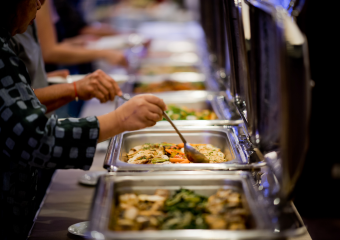Feeding America: The Battle for Daily Nutrition | Texas News | inforney.com – inForney.com

This May, nationwide Mexican dining chain Chipotle contributed free burritos to American healthcare workers for National Nurses Week. The gesture awards more than $1,000,000 worth of complementary burrito e-cards to 100,000 medical professionals in honor of their service.
Of course, generous offers from food and beverage companies are nothing new, and kind gestures like Chipotle’s warrant gratitude from all the workers who receive them. Yet, ironically, the industry members who advise the public on physical well-being may not themselves be living their healthiest lifestyles.

Earlier this year, business catering specialists ezCater reported healthcare workers were more prone to missing meals and taking shorter breaks than the average American employee.
Healthcare Workers Burned Out
Furthermore, a 2023 American Journal of Lifestyle Medicine study found that half of American healthcare workers experienced burnout. Incidentally, the same investigation cited less than 40% of Australian professionals as saying they eat a “very good” diet. Only a fraction said they consume the regular five-a-day serving of vegetables. Clearly, this isn’t only an American problem.

Food and Mental Health
Research shows diet can have a major influence on mental health; a deficiency in foods containing zinc, vitamin B12, and folate (B9) can lead to several negative outcomes, including depression, brain function decay, and physical tiredness. Therefore, the wider nutritional situation outside the hospital walls is another facing upheaval — Americans face a battle to eat well.
In other developed regions such as Europe, access to fresher foods is key to a more nutritious eating culture. Many developed countries focus on locally sourced, seasonal, and pollution-free ingredients — access to which the average American citizen lacks. For those living at the fringes, a balanced diet just isn’t an option in post-pandemic America.
The American Diet Question
Those with a stable home and income are generally better off, though a solid family base isn’t necessarily a marker of a balanced diet. A recent American Association for the Advancement of Sciences (AAAS) report shows how only one in three parents believes the standard American diet is nutritious. Only one in eight parents require children to eat everything on their plate, and at least 60% of parents offer to customize meals if their child doesn’t like what everyone else is eating.

University of Michigan Health C.S. Mott Children’s Hospital pediatrician Susan Woolford, M.D. says young children generally eat fewer foods than parents would like, and caregivers should model healthy norms in their own dietary choices.

“Preschool and elementary age is an important time to establish healthy eating patterns,” says Woolford. Yet parents’ concern…may lead them to adopt practices that actually sabotage their efforts.” Revealingly, the AAAS study shows that over half of parents say their child is a picky eater. The nutrition dilemma affects not only American kids but also Europe, which is experiencing a shift in nutritional awareness.
In Michael Moore’s Where to Invade Next?, he visits rural France and is overwhelmed by local schoolchildren’s knowledge of local produce, not to mention their haute cuisine school lunches. In contrast, a 2024 Harris Interactive Study, “The French and Daily Diet” delivers an indictment on a nation long known for its relationship to ingredients. The survey reveals 20% of French people aged 15 to 24 cannot identify a zucchini.
Healthy Food Access
Unsurprisingly, research shows that most Americans admit price is the largest barrier to a healthy diet. The Cleveland Clinic says 46% of Americans consider healthy food too expensive, while 20% said they are unsure how to cook a nutritious meal. Moreover, one in five African Americans struggles to buy from healthy food vendors.
Naturally, rising inflation has played a part in this struggle — according to Investopedia, it peaked at 8% in 2022, harming energy and food prices. The supply chain aftershocks of a seismic global pandemic and the ongoing conflicts in Ukraine, the Middle East, and the Red Sea have pegged some costs permanently. What’s more, Nature Food released a 2022 review showing countries with higher COVID-19 case counts experienced, on average, the highest food cost increases.
The Farm Bill
Fortune writer Gene Bauer wrote last year about how the 2023 Farm Bill is to blame for extreme food costs, namely on fresh produce. The omnibus bill reemerges every five years, and the latest edition will see $700 billion spent in the next half-decade, though not necessarily to meet Americans’ dietary needs. The government now funds 73% of the U.S. dairy industry’s income — a pertinent example of what Bauer says is misguided spending.
Another overlying issue behind American workers’ lack of nutrition isn’t money but a lack of time. Although Americans work fewer hours per week than other developed countries, they still work more than most OECD countries. Furthermore, a quarter of Americans say finding time to eat well was hard. Regardless, the signs are promising: Statista found last year that half of Americans are now attempting to eat better, with baby boomers leading the way.
Nutrition Hacks
There are many ways to supplement a healthy diet that needn’t break the bank. Alex Caspero, a registered dietician at Delish, believes one simple way to improve nutrient intake is embracing the frozen food aisle. He says frozen vegetables and fruit can give those on a tight budget much-needed vitamins, especially in dishes less reliant on texture, such as soups or stews.
“Frozen fruit and vegetables are frozen at the ‘peak of ripeness,’ which means that they are frozen quickly after being picked, retaining their nutrient value,” says Caspero. “Considering that nine in 10 American adults don’t consume enough fruits and vegetables each day, relying on frozen (and canned) produce is an economical way to do so.”





